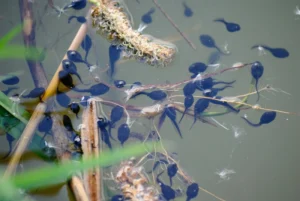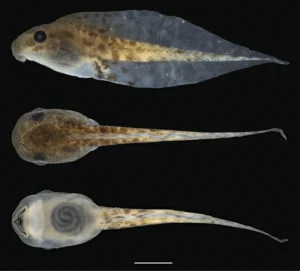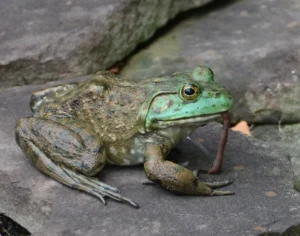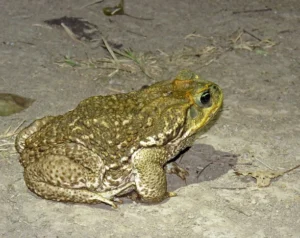Frogs are amphibians, which means they live part of their lives in the water and part on land. They typically start their lives as fully aquatic tadpoles, which metamorph into mature frogs over time. In each of these life stages, they will have different diets.
Frog tadpoles are herbivores, and eat algae and the soft roots and leaves of aquatic plants. As they grow, the tadpoles will become omnivores and will eat animal protein, in addition to plants. Once the tadpoles go through metamorphosis and transform into frogs – they become obligate carnivores.
Tadpoles have “beaks” that help them to scrap off algae that grow on plants, rocks, or the surface of the water.
In addition, they have very long tightly coiled intestines, suited for their mostly herbivorous diet.
Frog Tadpoles Are Mostly Herbivorous
Most frogs start their lives as fully aquatic tadpoles. When they first hatch, tadpoles will have poorly developed gills, mouths, and tails – so they can not properly swim or eat yet.
For this reason, they will spend the first few days feeding on the remaining yolk of the eggs. This will provide them with enough energy to grow and develop further.
After about a few days, the tadpoles would have developed enough to start free swimming and feeding on food sources available in the water.

At this early stage, tadpoles are almost completely herbivorous, and will eat:
- Algae
- Soft roots and leaves of aquatic plants (eg. duckweed mosses)
- Plankton
- Detritus (mostly composed of degraded plant materials)
Tadpoles have little or no tongue-like tissue and will eat by sucking the food into their throat and the food enters the long intestine where it is digested.
Due to a mostly herbivorous diet, tadpoles have very long tightly coiled intestines, that make up more than half of their body mass.
Plants contain cellulose, a compound that is very hard to digest. Because of this, plant matter needs to spend more time in the digestive system. This long intestinal tract gives tadpoles more time to break down the plant matter and absorb as many nutrients as possible.
The intestine takes up about half the space within the tadpole’s body and can be more than ten times longer than the tadpole itself.
It is also its largest organ and is visible through the translucent belly skin.

As the tadpoles grow their intestinal tract will gradually shorten. At this point (about 6 weeks into their development), the tadpoles become omnivores and eat animal matter in addition to plants.
They will also eat:
- Aquatic insect larvae (glass worms, mosquito larvae, etc)
- Water striders
- Small insects that fall into the water
- Worms
- Carcasses in the water
Tadpoles Turn Into Froglets
After a few months, to a few years (depending on the species) the tadpoles will go through a process known as metamorphosis, in which they will transform into juvenile frogs.

During this process, the tadpoles:
- Lose their gills and get well-developed lungs for breathing air
- Absorb the tail into the body
- Develop strong legs for moving on land
- Remodel other organs to form an adult frog
The tadpole’s beak is also shed, the denticles are reabsorbed, the mouth as a whole widens, and many frogs’ true teeth form.
In addition, the digestive tract shortens dramatically, and the inner lining of the remaining intestine thickens, creating many folds in the process. These folds create a very large surface for the absorption of nutrients during digestion.
As the gut shrinks, a stomach is formed that secretes enzymes for digesting proteins.
Adult Frogs Are Not Herbivores
Once the metamorphosis from tadpole to frog is complete – frogs will not be herbivores, or omnivores anymore. Instead, they become obligate carnivores, which means they stop eating plant matter and will only eat animal matter.
They will eat :
- Grubs, Worms, slugs, snails
- Spiders, cockroaches, wasps
- Grasshoppers, moths, butterflies
- Crickets, beetles, flies, and a wide variety of other insects
Frogs are not picky eaters so almost any prey they can overpower and fit into their mouth is on the menu.
Larger frog species also eat small fish, small birds, bats, mice, and even snakes and other small reptiles.

Frogs are generally attracted to movement while hunting for food. For this reason, most frogs will not eat dead bugs, or any other dead prey items.
Adult Frogs Do Not Have a Digestive System Suited for Digesting Plant Matter
Adult frogs generally have short alimentary canals, suited for their strictly carnivorous diets.
Carnivorous animals like frogs generally have shorter digestive tracts than herbivores – because meat is dense in nutrients and they can extract these nutrients easier.
Their stomachs also make up a larger part of their digestive system than herbivores.
In addition, frogs have very powerful digestive enzymes, that help them to easily digest animal protein.
However, adult frogs may occasionally ingest plant matter when they eat hunt and eat prey – but they will never deliberately eat plants.
Some Adult Frog/Toad Species Are Omnivores
Cane toads (Rhinella marina) mostly eat insects, worms, snails, smaller frogs, small mammals, and other prey items.
However, they have also been observed eating carrion, processed cat and dog food, household garbage scraps, and even animal excreta.
This means they are omnivores, rather than obligate carnivores, like most frogs are in the adult life stage.

Unlike most frogs that find their prey by movement, cane toads primarily use vision to find prey, and can also use their sense of smell to find food, such as dog food left outdoors.
The Frugivorous Frog
There is one frog that is known to eat plants as part of its regular diet: the Izecksohn’s Brazilian tree frog (Xenohyla truncata).
These frogs unique in that they are the only known frugivorous frog, out of more than 7,000 frog species in the world. They intentionally and often eats fruits, leaves, and flowers.
The amount of plant matter eaten by Izecksohn’s Brazilian tree frogs will depend on the blooming and fruiting seasons of the plants. When plants are unavailable, these frogs will eat various arthropods instead.
Since these frogs eat plants, in addition to animal matter, they are omnivores – rather than obligate carnivores.
Frogs Are Good for Your Garden
Frogs will not eat your garden plants but will eat grasshoppers, snails, slugs, and other pests that do.
Having frogs in your garden can reduce pest problems, without the need for pesticides.
In addition to eating pests, frogs are great bio-indicators that can tell you about the health of your garden ecosystem.
Having frogs in your garden is a great sign that you have a clean, thriving, and healthy garden ecosystem.
They can’t live in polluted habitats and are sensitive to changes in their environment, so the presence of frogs or toads is a sign the habitat is healthy.
A sudden change in their presence can show that your garden has become polluted, or is unbalanced.
Having Lots of Frogs in Your Garden Can Attract Snakes
It is important to note that having lots of frogs around can also attract predators such as hungry snakes looking for a meal.
Frogs are one of the main prey species for many snakes around the world.
For example, in North America, the primary food of the eastern hognose snake is toads.
In fact, Eastern hognose snakes are so specialized in eating toads, that they have large teeth in the back of their mouths to puncture inflated toads to make them easier to swallow.
Garter snakes are also heavily reliant on frogs and other amphibians as food.
That being said, having snakes in your around is not always something to worry about. Some snake species such as garter snakes and rat snakes are generally harmless to humans and eat pests such as rodents and slugs.
Kingsnakes(which are also harmless to humans) are even known to eat venomous snakes such as copperheads and rattlesnakes – helping keep these potentially harmful snakes off your yard.
Common Questions
Do Frogs Eat Grass? Frogs do not eat grass. They are generally obligate carnivores, which means they only eat animal matter to obtain all the nutrients they need. Unlike herbivorous animals, frogs have short digestive tracts – suited for a carnivorous diet, and can not digest grass.
Conclusion
Frogs begin their lives as mostly herbivorous tadpoles. Over time, these tadpoles go through metamorphosis and transform into adult frogs.
As adults, the vast majority of frog species are obligate carnivores, but there are also a few omnivorous frog/toad species.
However, there are no herbivorous adult frogs.


